
Valve Spring Cap Replacement
September 28, 2003 - Streamwood, Illinois
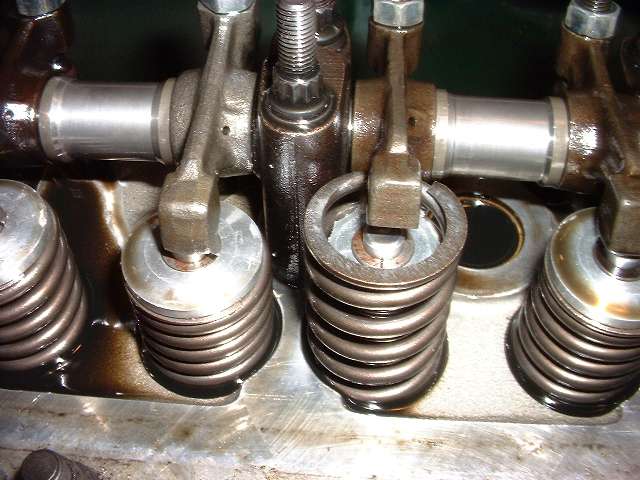
Broken alloy valve spring cap.
Pictures on this page are from David Bralich's daily driver MGB with aluminum cross flow cylinder head. The broken part is the alloy valve spring cap, Moss Motors part number 460-305. Some of these parts were apparently machined with a thin outer edge where it holds the outer valve spring. With sufficient running time that thin edge fatigues and fails, releasing the outer valve spring. This leaves the engine running with only the smaller inner spring to close the valve, and with insufficient spring force it will run into valve float at about 5000 RPM. For the two known failure cases so far in our club, it was fortunate that the failures happened at moderate engine speed, and the valve float was noticed immediately the first time thereafter when the engine speed hit 5000 RPM. In each case so far there was no additional damage to the engine (knock on wood).
This is the second reported case of this failure in our club this summer. Barney Gaylord had two of these alloy parts break in one day while driving his MGA in the Flying Low Rally on July 6. Close inspection of these alloy spring caps reveals that the parts that broke were machined with a thinner edge than most of the other parts, and it was this thin edge that led to the failure of the part. Barney’s engine had at least three of the eight parts with this thin edge condition, and two of those failed after 22,000 miles of running. Dave’s engine had only one of the eight parts with the thin edge, and that one broke with 15,000 miles of running. Incidentally, the soft aluminum parts also seem to be subject to some significant wear at the point of contact with the spring coils.
So we have this predicament. We know that at least two shops in the area have installed these parts in perhaps a dozen of our members’ cars. If you have an MG which has been fitted with these alloy valve spring caps, it would be a good idea to pull the valve cover to check. The outer edge of the parts should be 1/8 inch thick. If you have any which are thinner, it would be best to consider changing the parts before they break. Also, whether your parts are good or bad, please contact Barney Gaylord, who is collecting statistical data to determine the approximate likelihood of another part failure of this type. So far we have two failures in the only two cars known to have run them between 15,000 to 22,000 miles. With no other data in hand, this appears to be a 100% engine failure rate within that mileage range. But of course the data base is so far quite limited, and we are attempting to gather as much additional data as possible. Anyone viewing this page who has these parts installed in an MG engine is encouraged to contact Barney Gaylord with information on the details, whether your engine has had this failure or not, and please note the edge thickness dimensions of your existing parts.
Barney Gaylord - webmaster@chicagolandmgclub.com
David Bralich - tech@chicagolandmgclub.com
Click on small images for larger images. - Larger pics average 32KB.
|
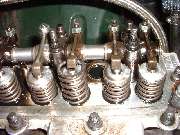 |
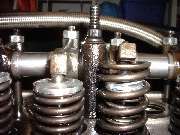 |
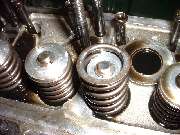 |
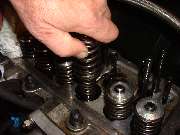 |
Above left, broken valve spring cap, and valve adjuster screw backed off allowing spring to push the rocker arm up away from the valve stem. Second picture shows the good spring cap with normal 1/8" thick edge, and the broken cap inside of the expanded outer spring. Third picture with rocker shaft assembly removed, looking into top of raised outer spring. Fourth picture, lifting off the outer valve spring without removing the broken reatiner cap.
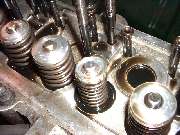 |
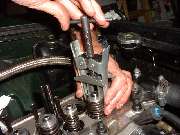 |
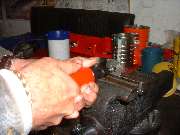 |
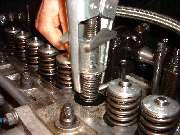 |
Above left, broken spring cap with outer spring removed. Second picture, valve spring compression tool being tested on a good spring assembly, as the broken spring cap is no longer large enough to support the tool. Solution is to use a flat washer with a large hole opened in the center to cover the broken cap to allow use of the spring compressor tool. Air pressure is applied to the spark plug port to hold the valve in place. The tool is then tapped on top to release the valve cotters which can be removed through the hole in the large flat washer.
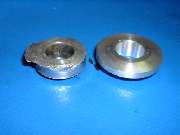 |
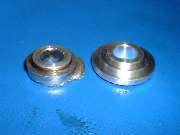 |
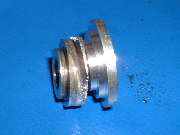 |
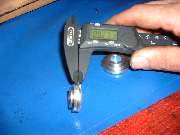 |
Above, pictures of the failed spring cap along with a new one with the normal intended dimensions, top, bottom, and edge vievs. It is apparent where the larger outer step in the broken part had been machined too far up, leaving a thin edge which would eventually fatigue and break in operation. Aside from checking for thickness of the edge of these parts, it is this author's opinion that the soft alloy part would fare better if there were thin hardened steel washers placed between the valve spring and the alloy cap to reduce wear. Maybe the proper solution should be to use a heat treated alloy to improve toughness and wear resistance.
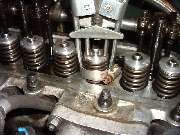 |
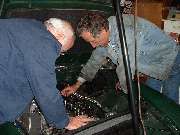 |
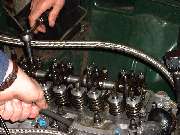 |
 |
Installation of the new spring cap with the double springs was a little tricky, as the spring compressor tool has rather short fingers that don't quite fully engage the inner spring coils. Solution was to install a screw type hose clamp to hold the legs of the tool securely in place during the operation. Third picture above shows removal of the flex hose connector that was screwed into the spark plug port to accept a quick disconnect air hose fitting. With all valve springs back in place, it's time to reinstall the rocker shaft assembly, re-torque the cylinder head, do the valve lash adjustment, and get this car back on the road.
Photos and web page courtesy of Barney Gaylord
More pictures of the broken parts from Barney Gaylord's MGA engine and another report can be found at:
http://mgaguru.com/mgtech/faulty/ft003.htm
----------
ADDENDUM Feb 13, 2004:
After additional correspondence and prompting, as of today Moss Motors states that they agree that these parts are not made consistnetly, that they have frozen current inventory, and that they will not sell any more of these parts until they can do 100% inspection of the existing parts. No word on whether they intent to attempt to contact past purchasers of these parts, so I advise anyone who may have any of these parts in their posession to check their parts. If they have been installed in an engine, this would require lifting the valve cover for inspection.
Photos and web page courtesy of Barney Gaylord
|
| | | |

©2003 Chicagoland MG Club, All rights reserved.
|
|